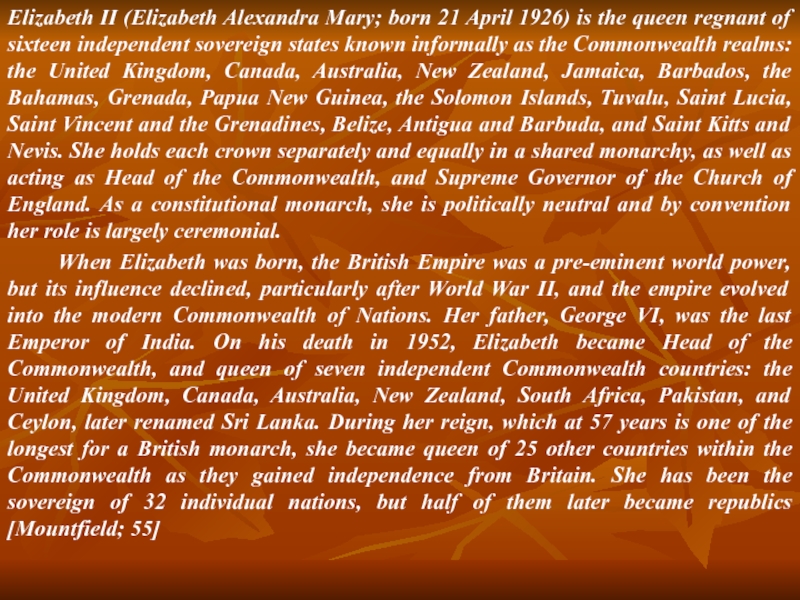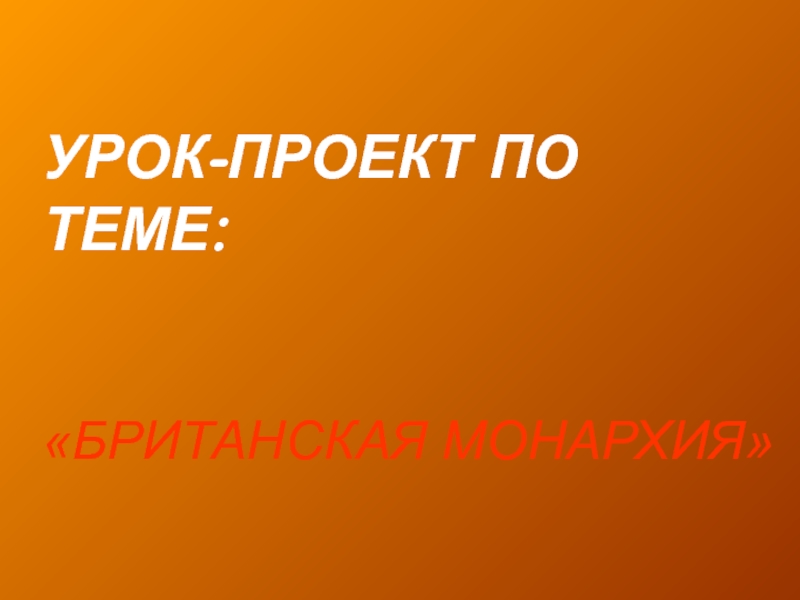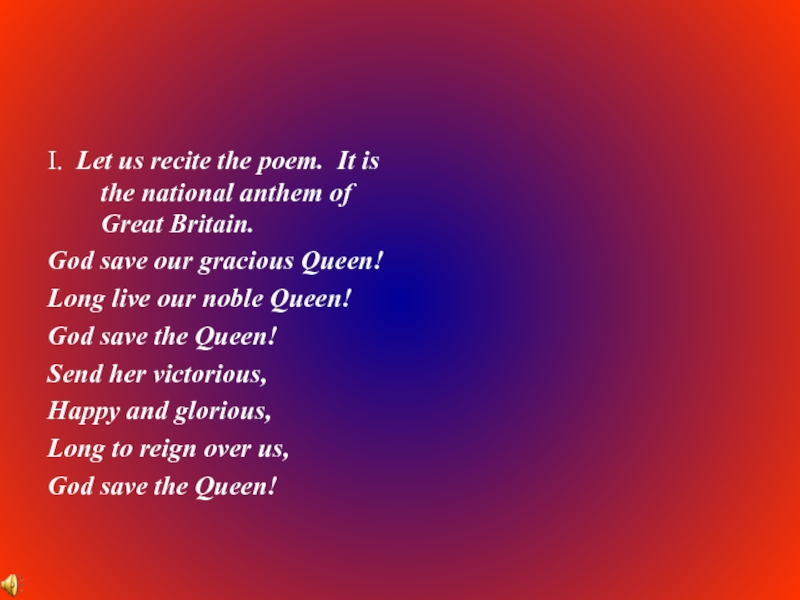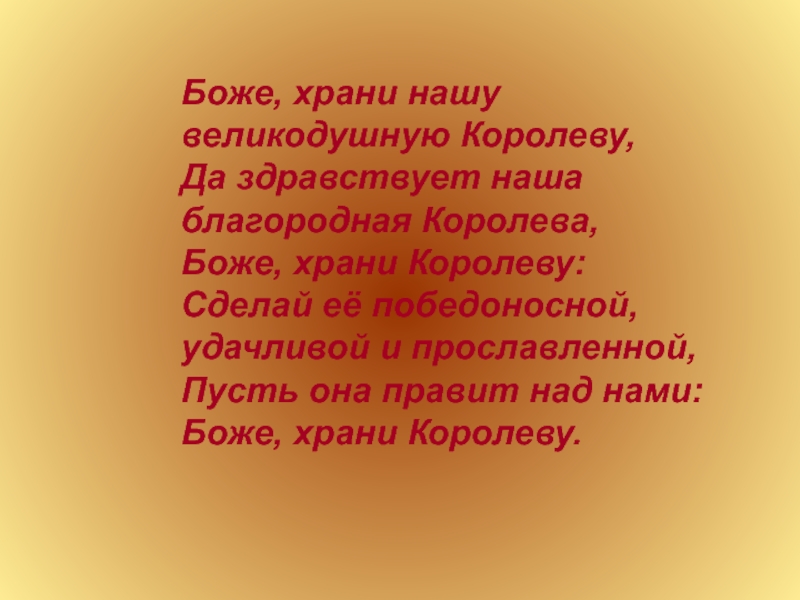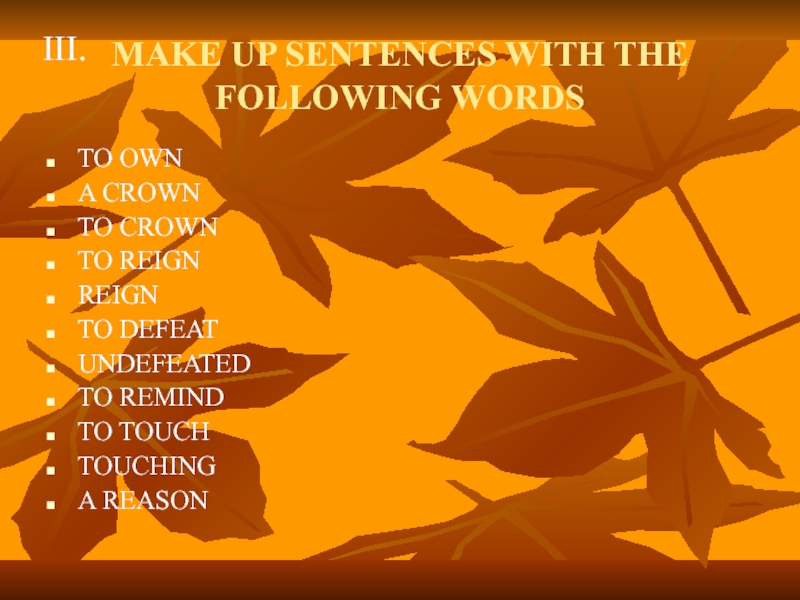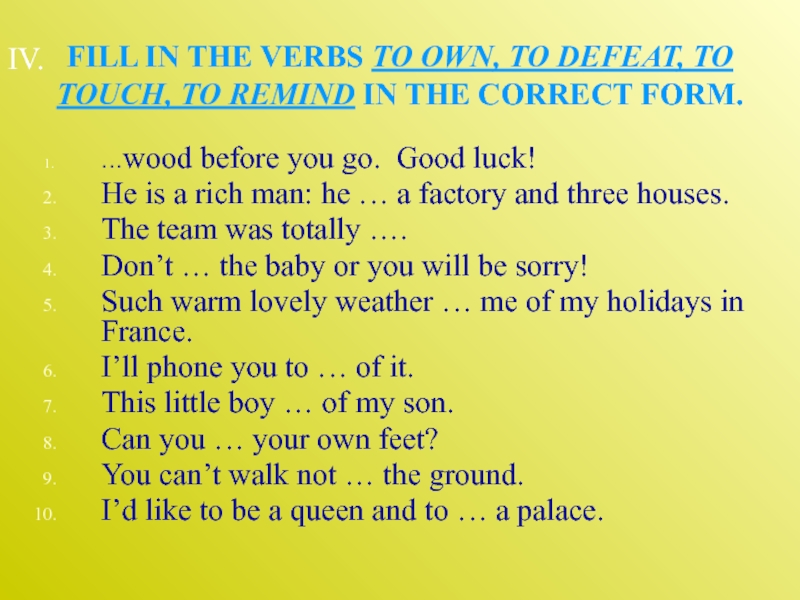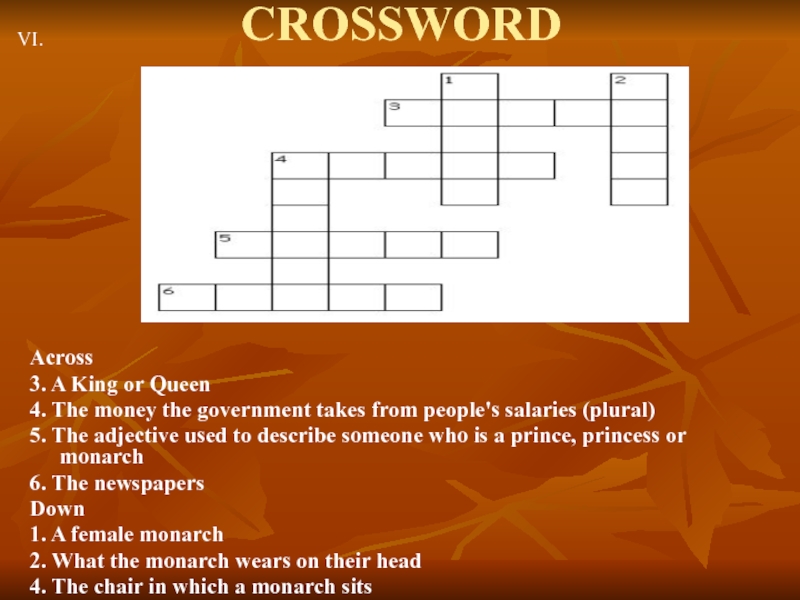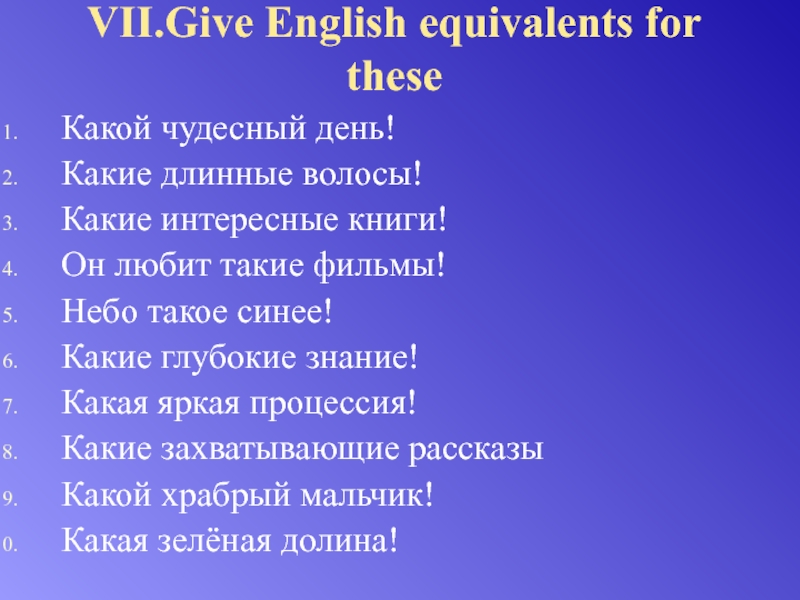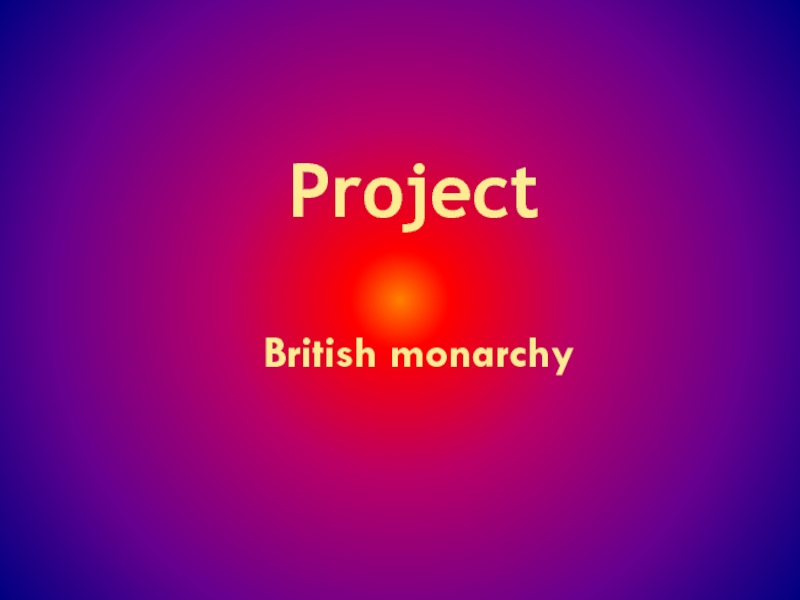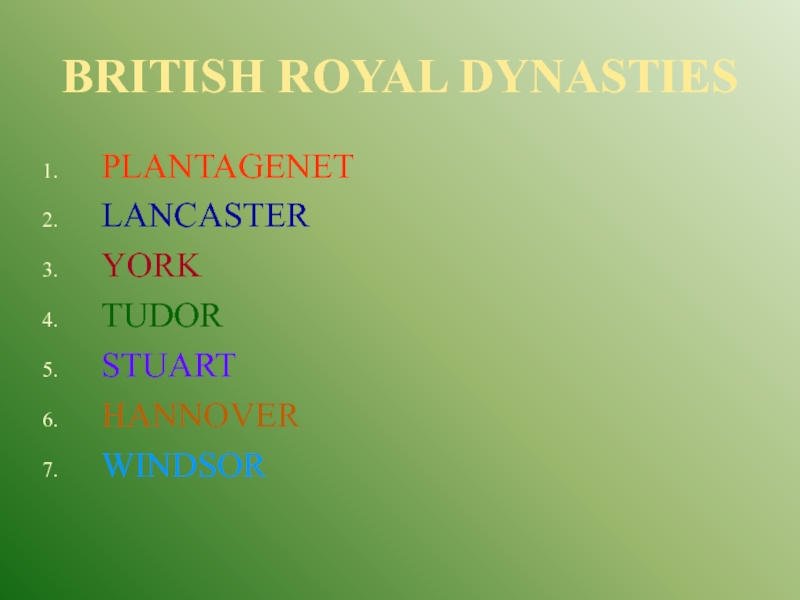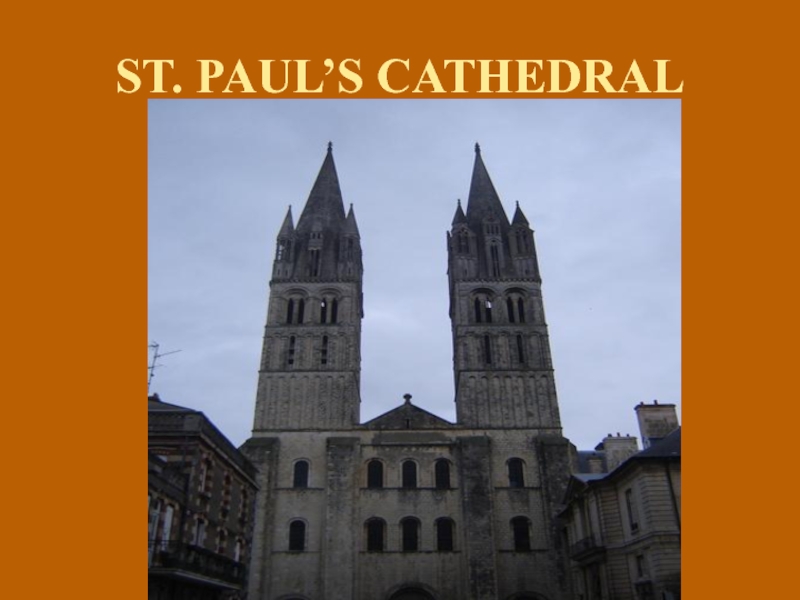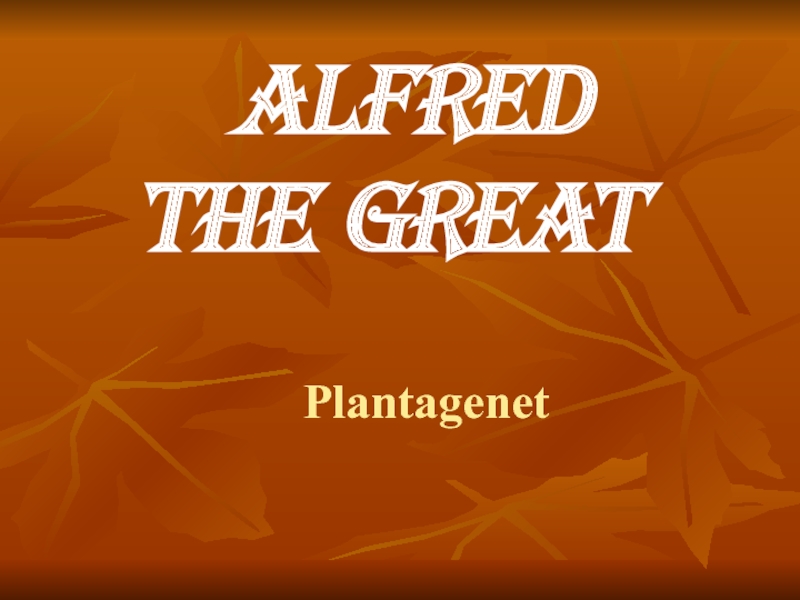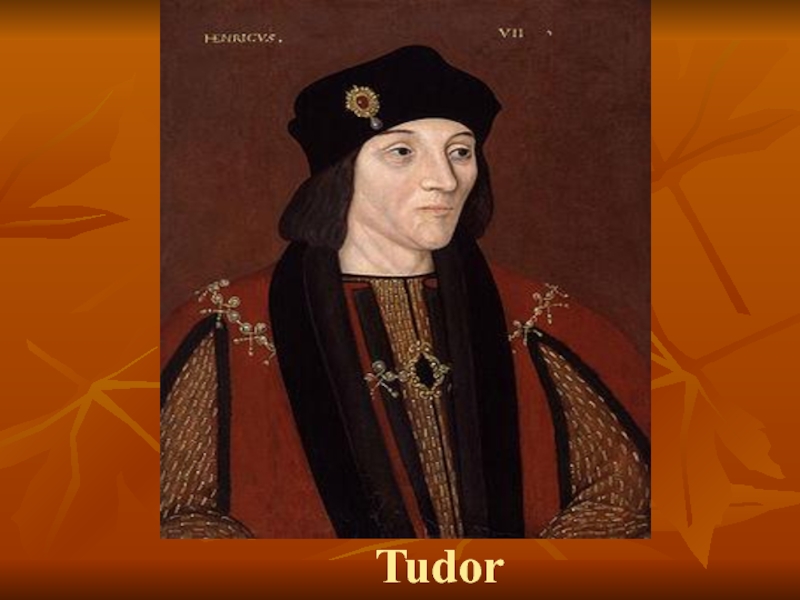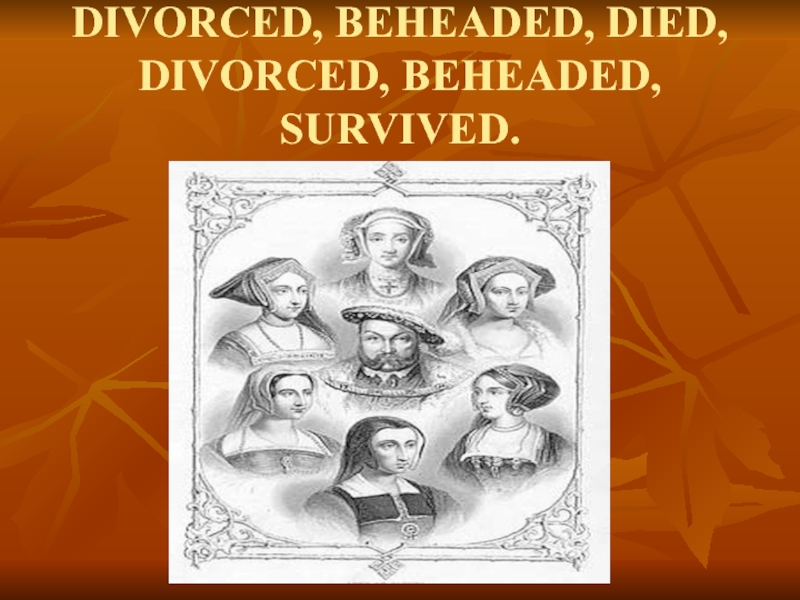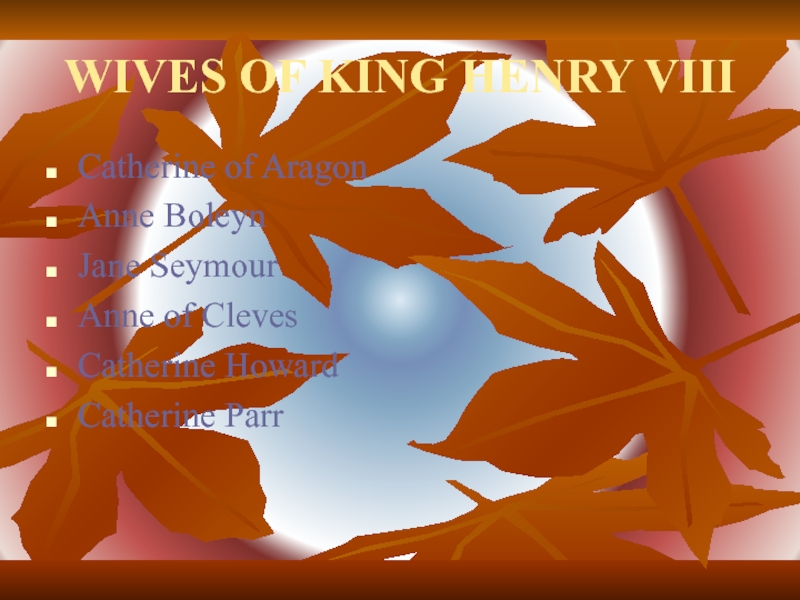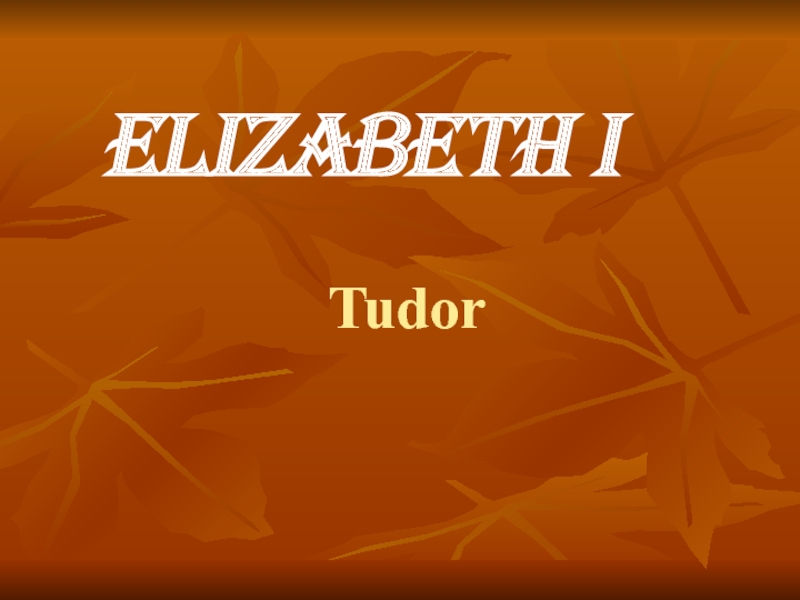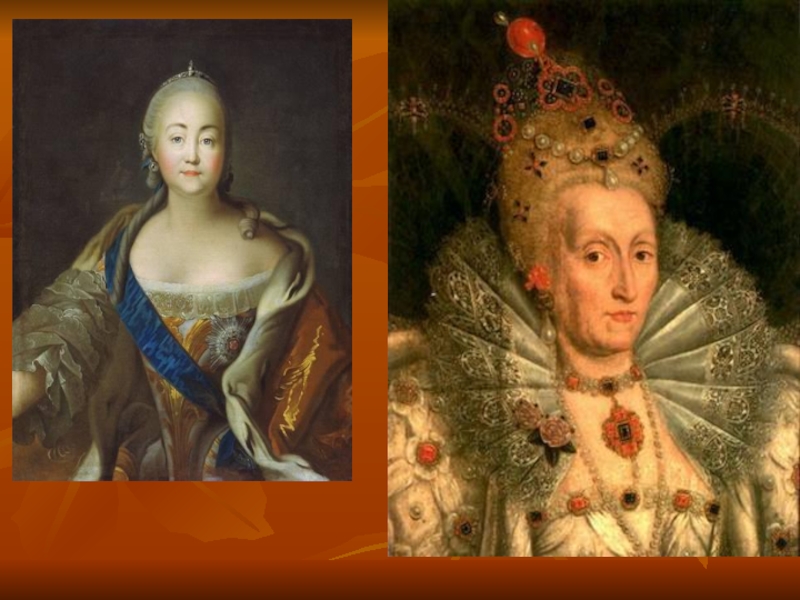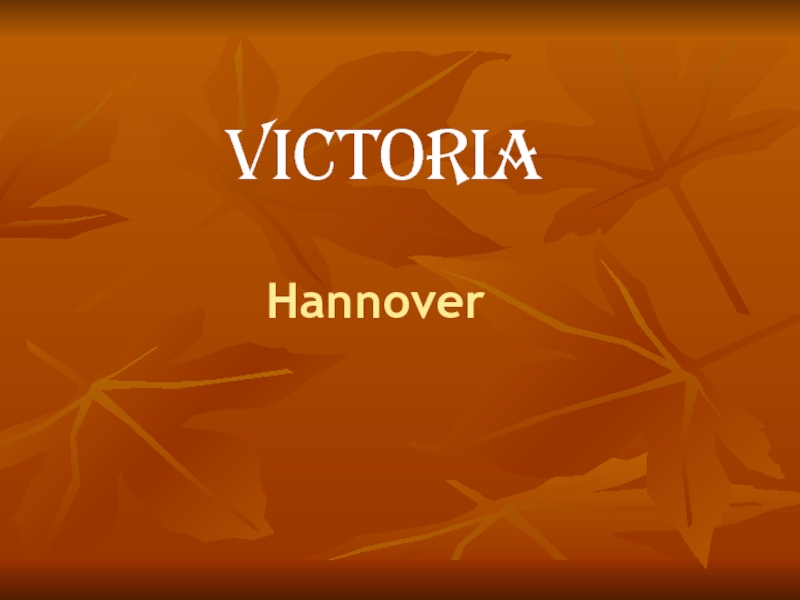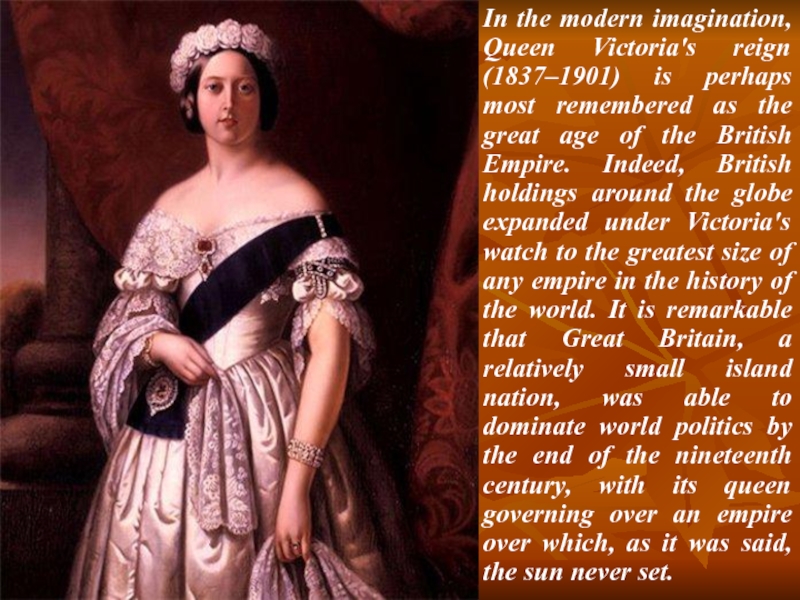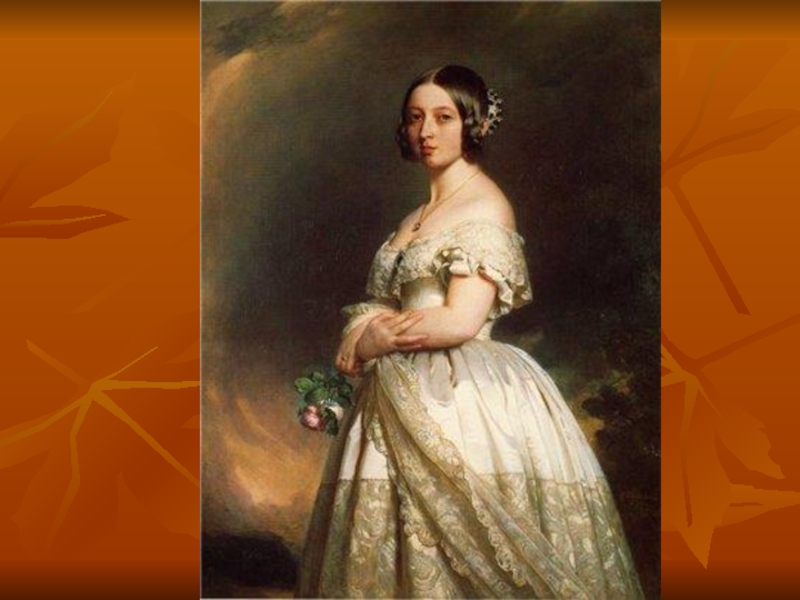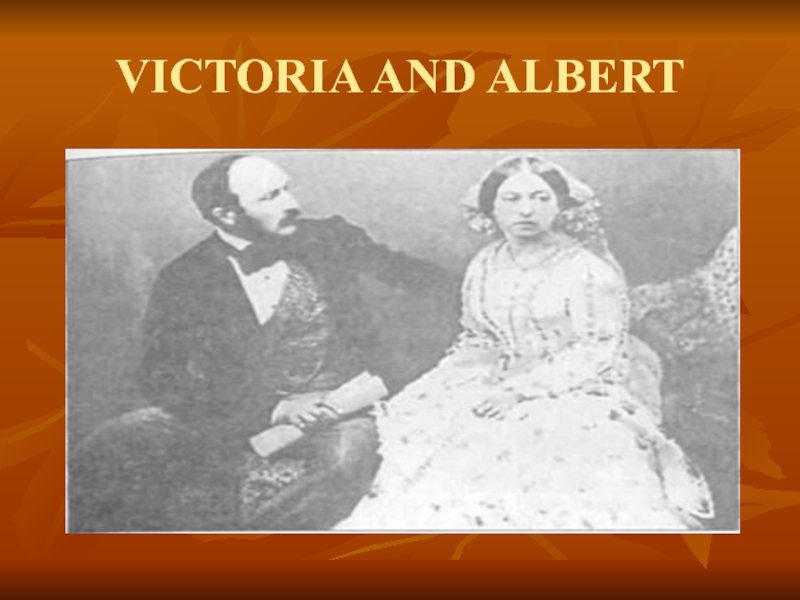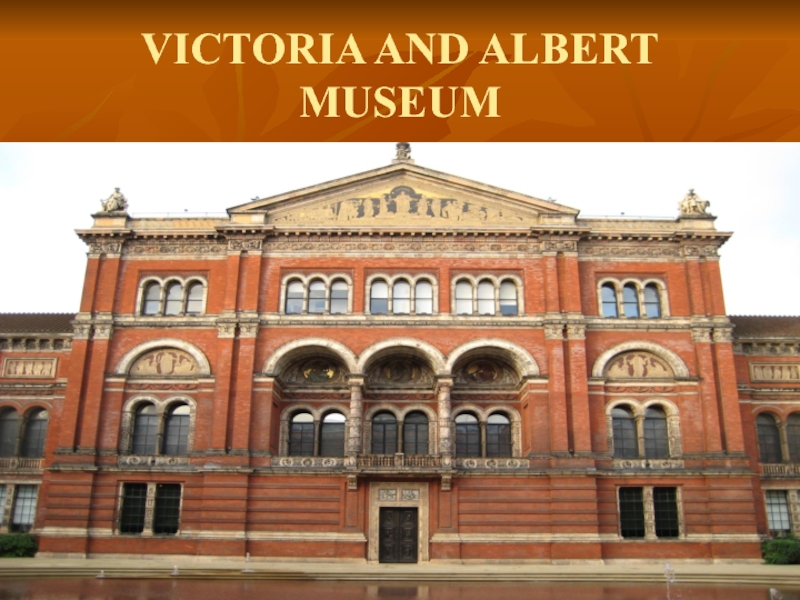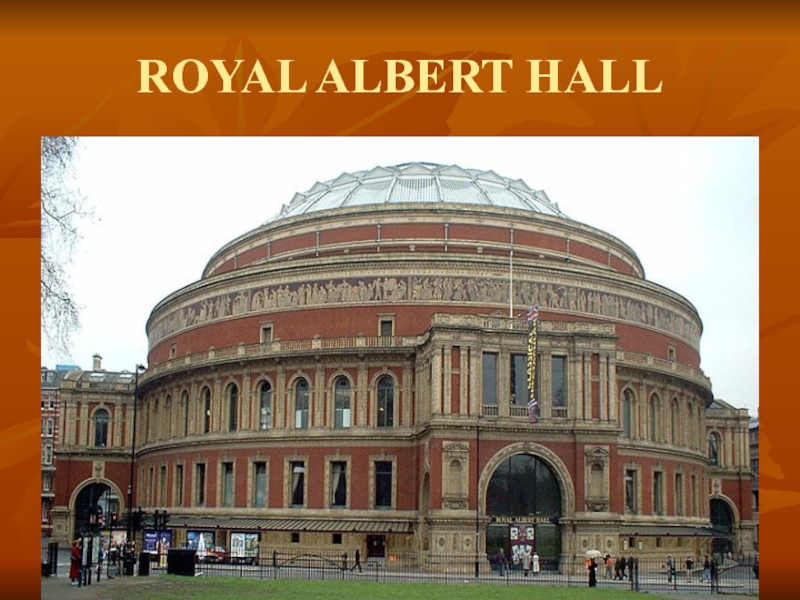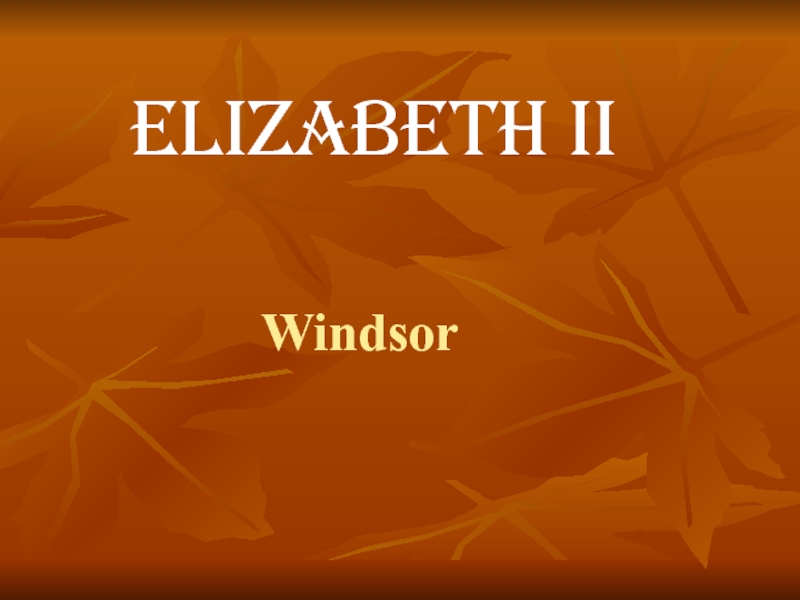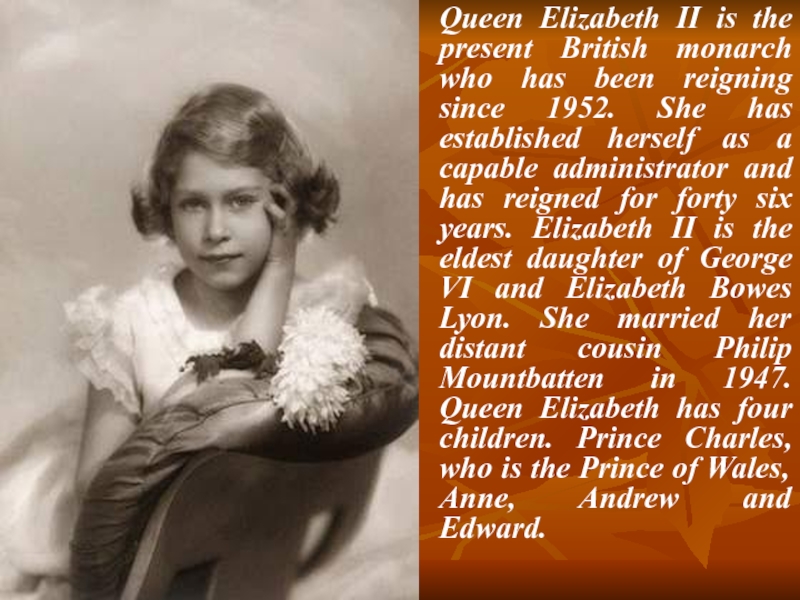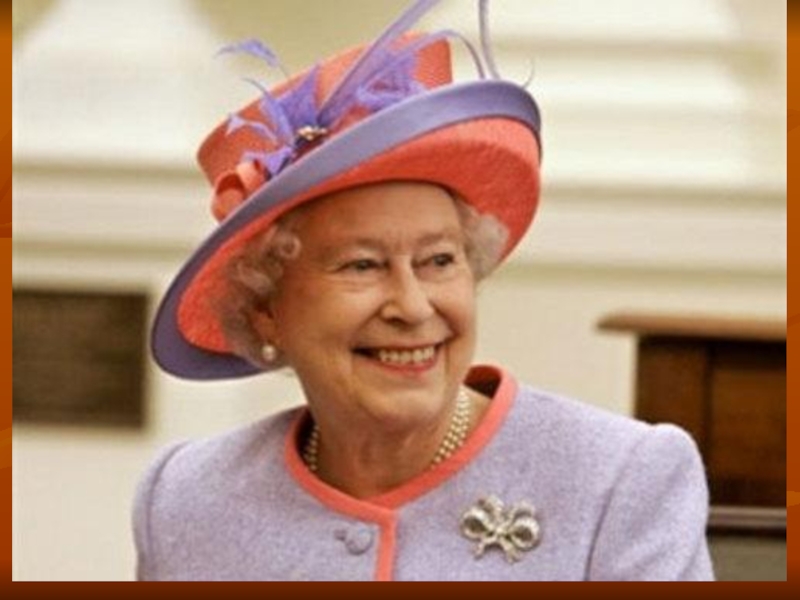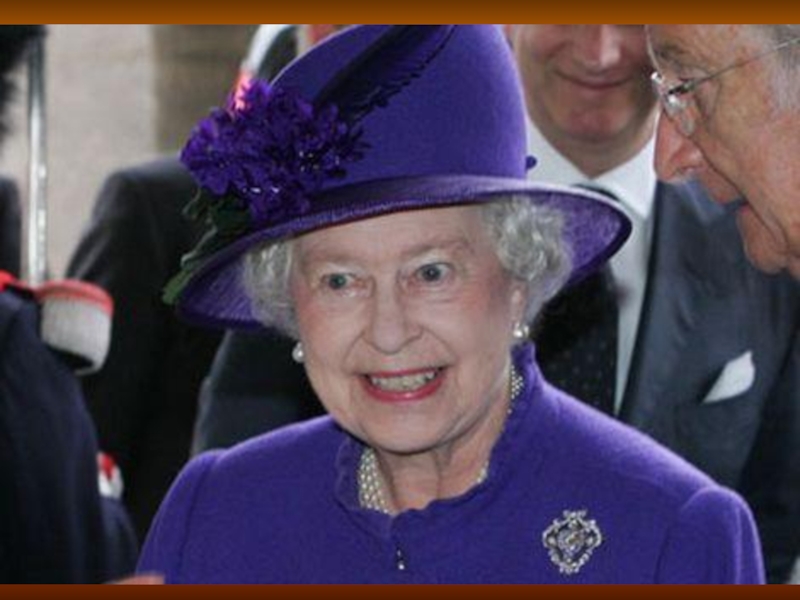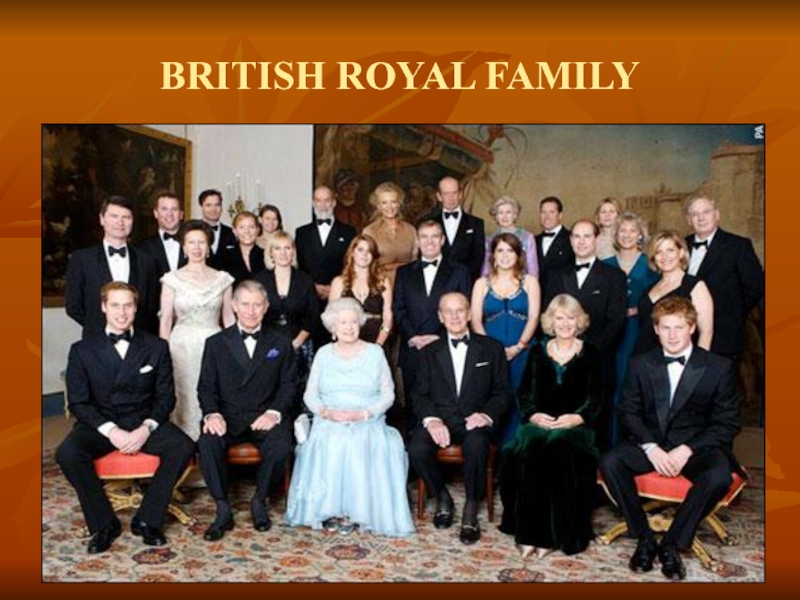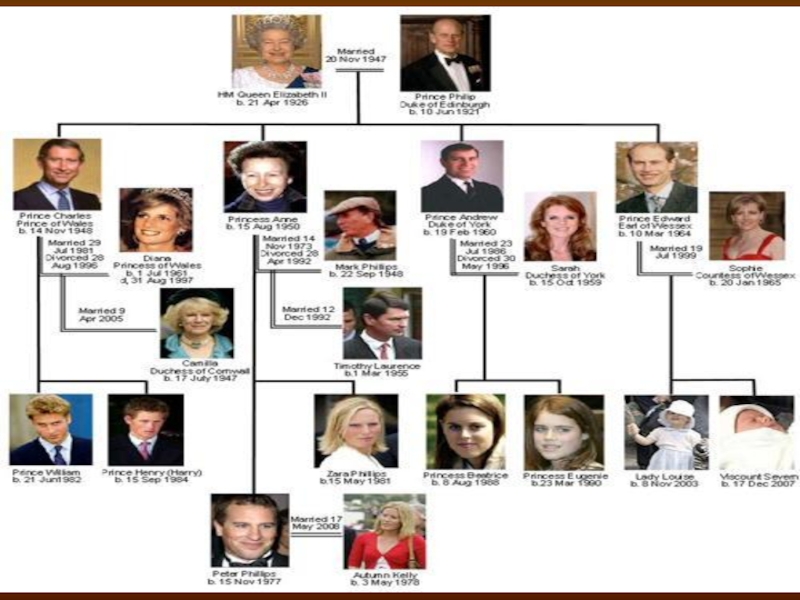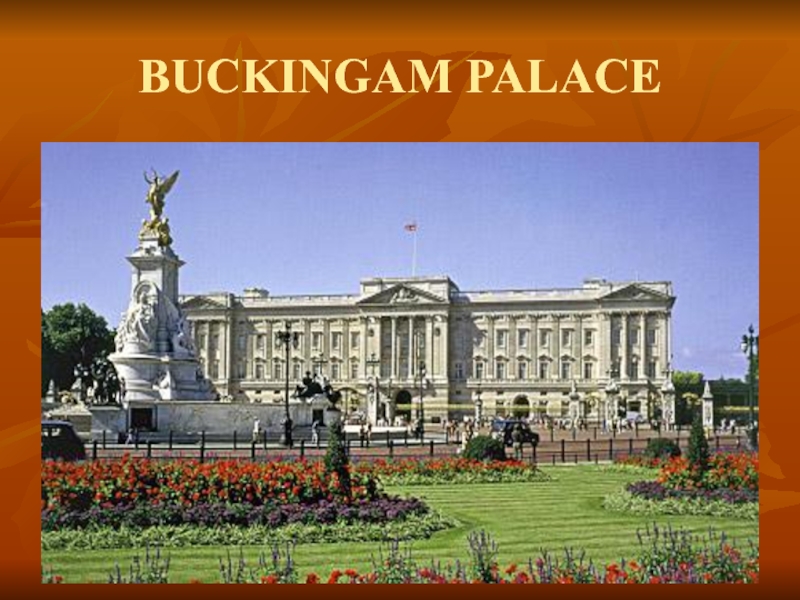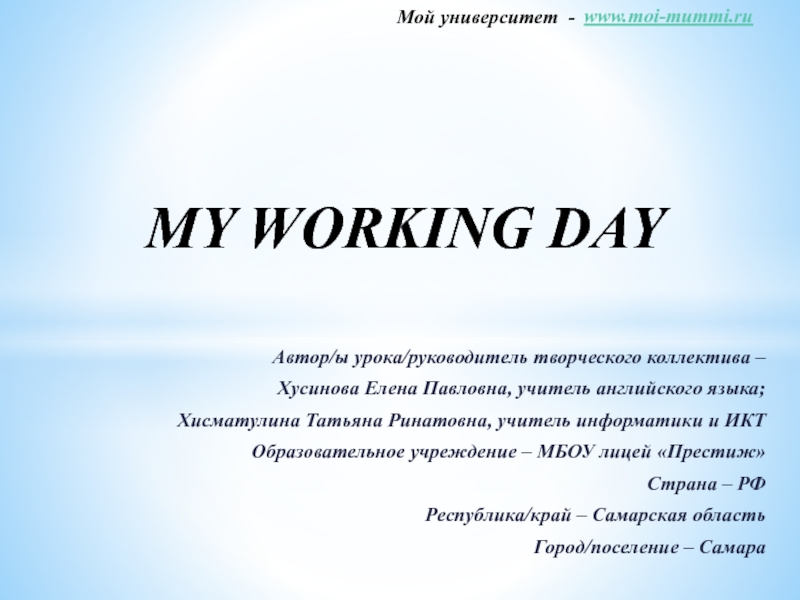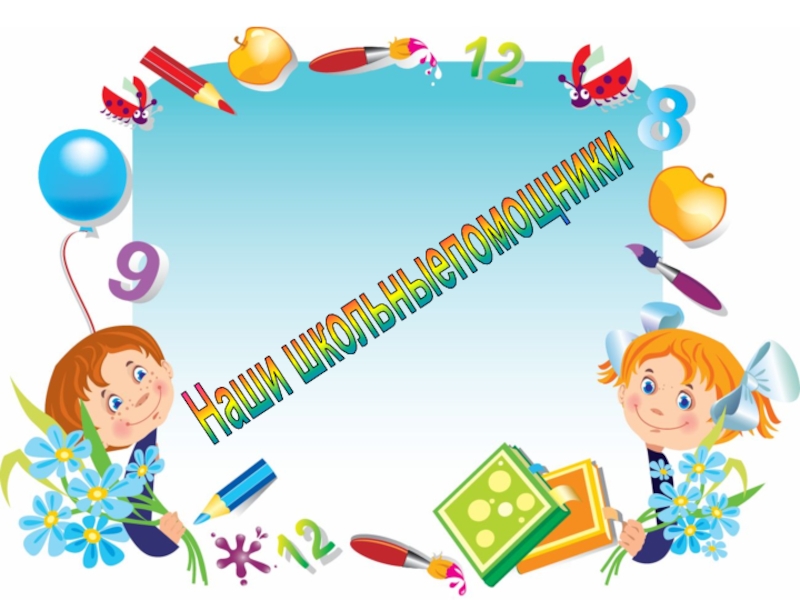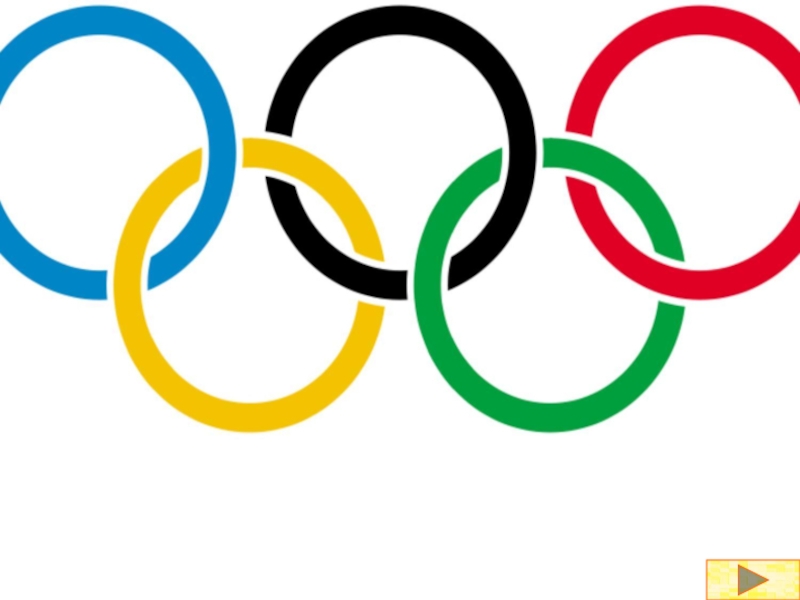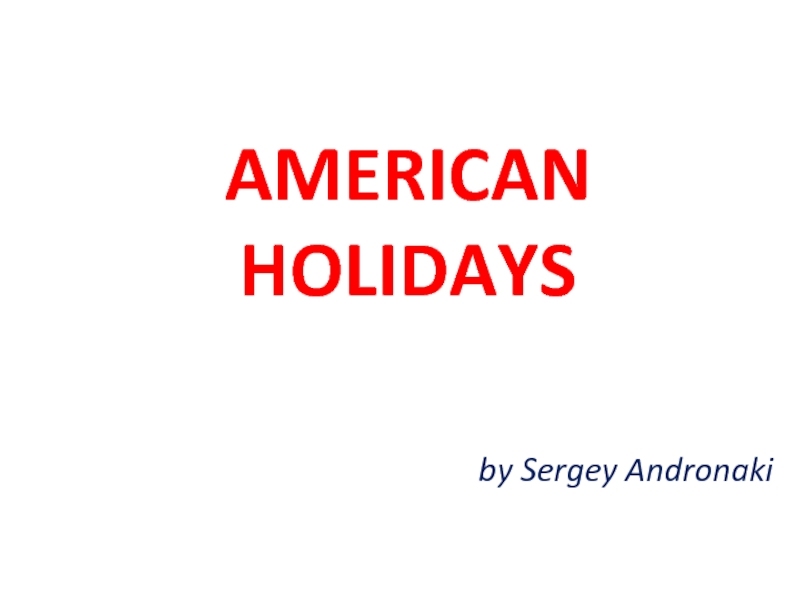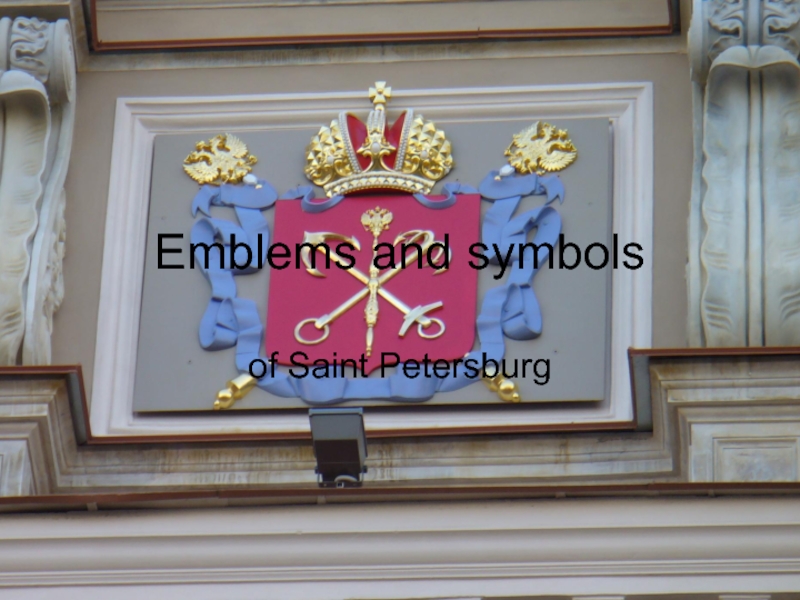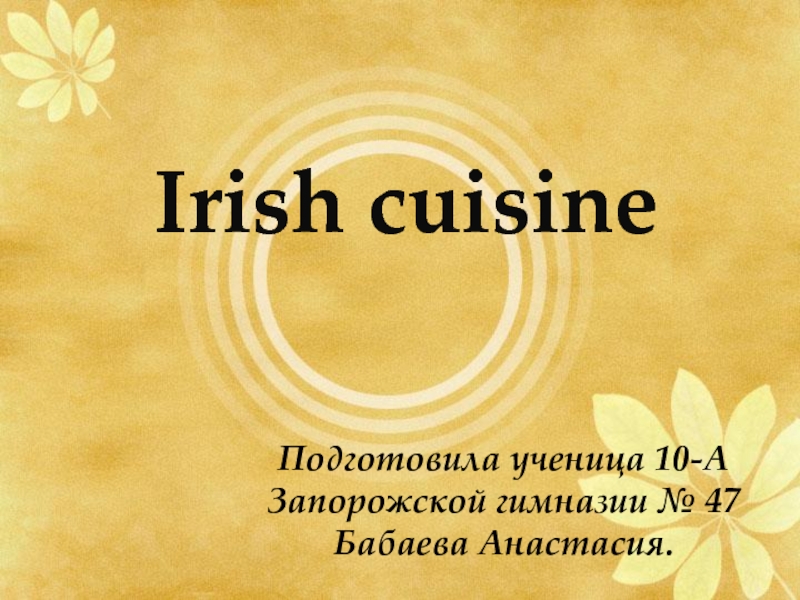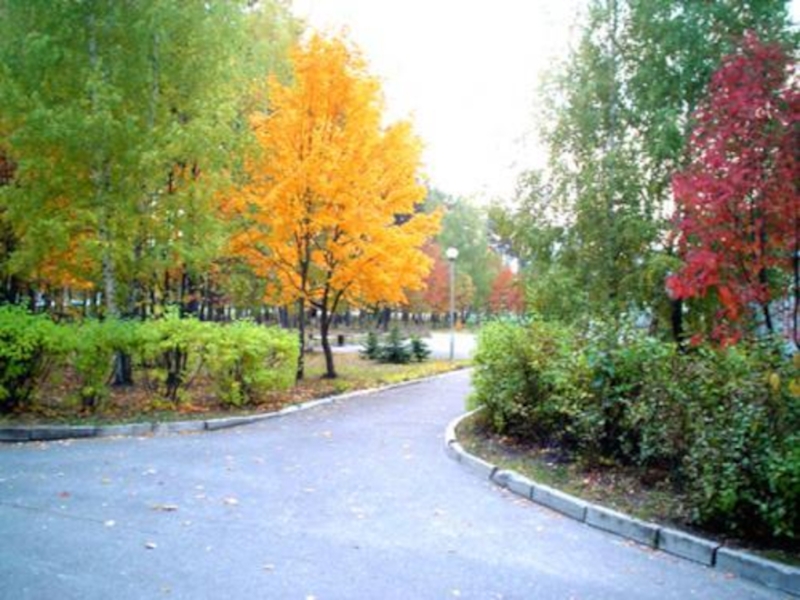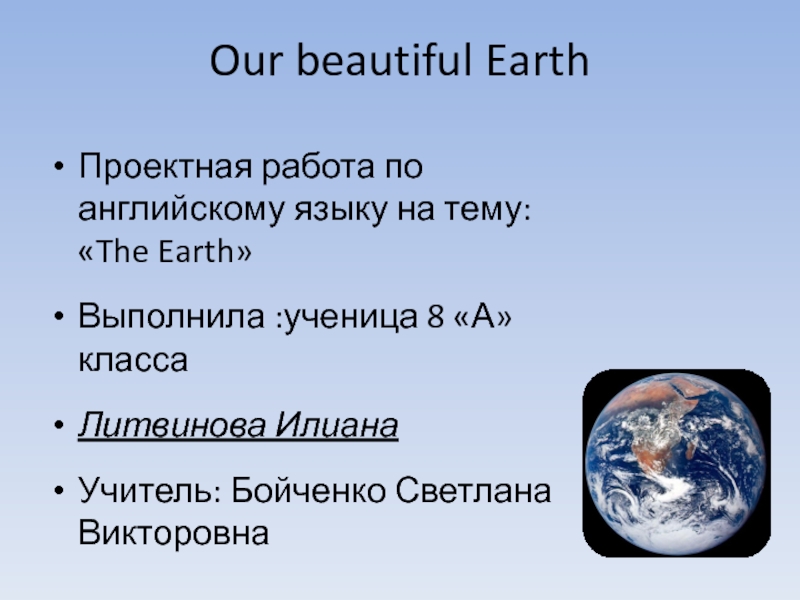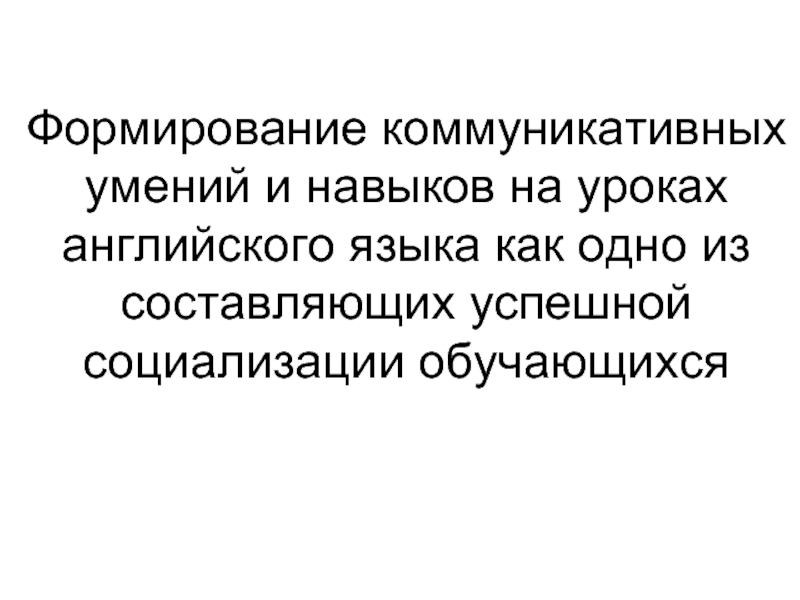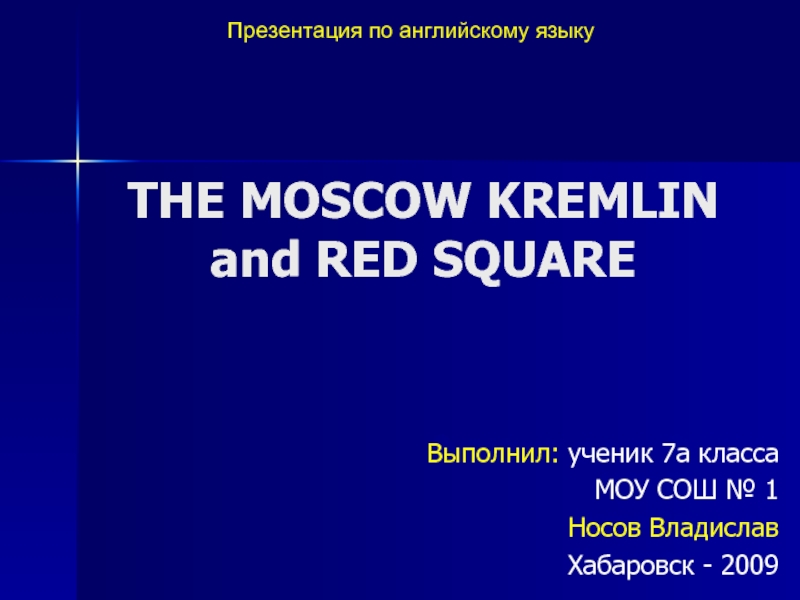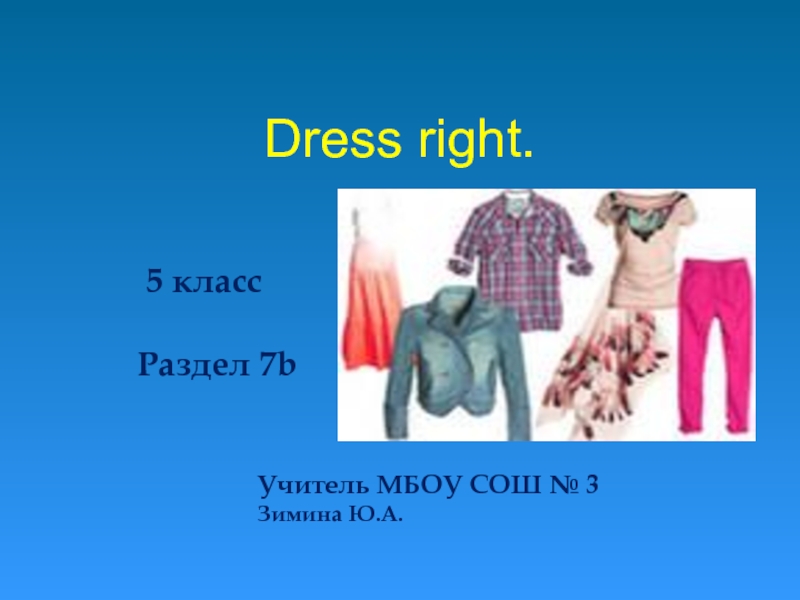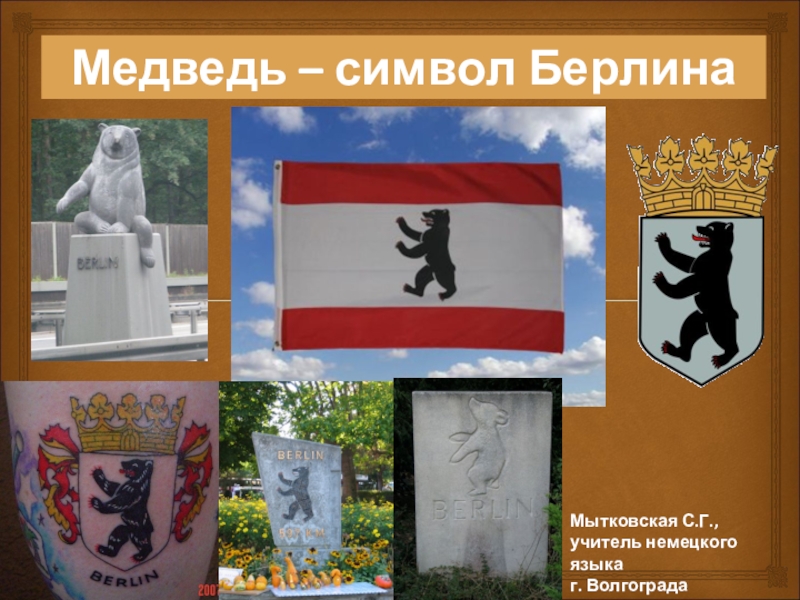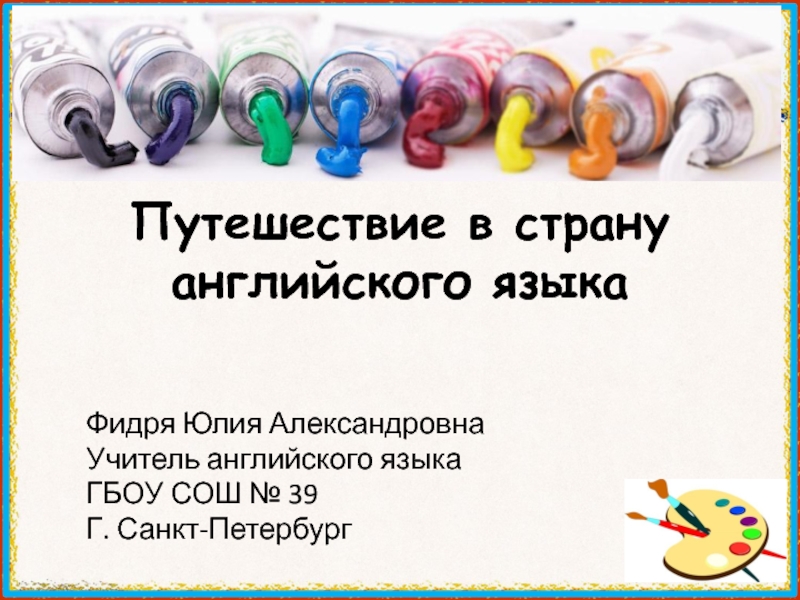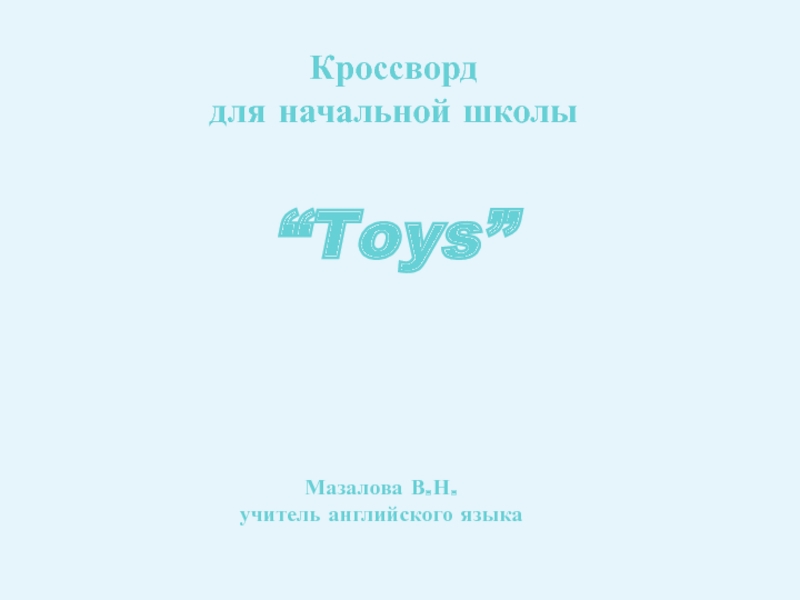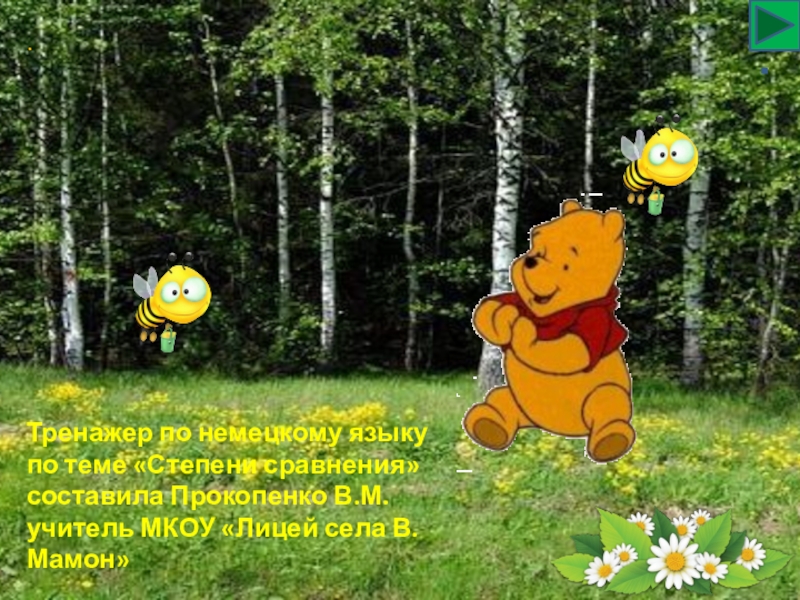Слайд 1УРОК-ПРОЕКТ ПО ТЕМЕ:
«БРИТАНСКАЯ МОНАРХИЯ»
Слайд 2I. Let us recite the poem. It is the national
anthem of Great Britain.
God save our gracious Queen!
Long live our
noble Queen!
God save the Queen!
Send her victorious,
Happy and glorious,
Long to reign over us,
God save the Queen!
Слайд 3Боже, храни нашу великодушную Королеву,
Да здравствует наша благородная Королева,
Боже, храни Королеву:
Сделай её победоносной,
удачливой и прославленной,
Пусть
она правит над нами:
Боже, храни Королеву.
Слайд 4Match the English words and their Russian equivalents.
official ceremony
1. резиденция
residence. 2. империя
avenue. 3. монарх
procession. 4. контролировать, проверять
public. 5. процессия, шествие
character. 6. классический
monarch. 7. официальная церемония
politics. 8. трагедия
control. 9. проспект, широкая улица
throne. 10. публичный
tragedy. 11. персонаж
classical. 12. политика
empire. 13. трон
II.
Слайд 5MAKE UP SENTENCES WITH THE FOLLOWING WORDS
TO OWN
A CROWN
TO CROWN
TO
REIGN
REIGN
TO DEFEAT
UNDEFEATED
TO REMIND
TO TOUCH
TOUCHING
A REASON
III.
Слайд 6FILL IN THE VERBS TO OWN, TO DEFEAT, TO TOUCH,
TO REMIND IN THE CORRECT FORM.
…wood before you go. Good
luck!
He is a rich man: he … a factory and three houses.
The team was totally ….
Don’t … the baby or you will be sorry!
Such warm lovely weather … me of my holidays in France.
I’ll phone you to … of it.
This little boy … of my son.
Can you … your own feet?
You can’t walk not … the ground.
I’d like to be a queen and to … a palace.
IV.
Слайд 7TEST
What is Mall?
a park b) an avenue
c) a palace
Where is London Zoo situated?
in
Hyde Park b) in St. James’s Park c) in Regent’s Park
What was Henry VIII’s surname?
Stuart b) Tudor c) Windsor
How many wives did Henry VIII have?
6 b) 4 c) 8
Who was Elizabeth I’s father?
Prince Albert b) the Spanish King c) Henry VIII
How long did Queen Victoria rule the country?
42 years b) 64 years c) 46 years
What is the Royal Albert Hall?
a palace b) a museum c) a concert hall
Who said: “ I know I have a body of a weak and feeble woman, but I have the heart and stomach of a King”?
a) Elizabeth I b) Victoria c) Elizabeth II
V.
Слайд 8TEST
9.Elizabeth II is Queen Victoria's…
a) Granddaughter b) great –granddaughter c)
great - great – granddaughter.
10.Prince Charles is…
a)Prince of England b)
Prince of Wales c) Prince of Scotland.
11.Elizabeth II has been British Queen since
a)1952 b)1962 c) 1972.
12.The Queen's husband is
King Philip
Prince Philip
Duke Philip
Слайд 9CROSSWORD
Across
3. A King or Queen
4. The money the
government takes from people's salaries (plural)
5. The adjective used
to describe someone who is a prince, princess or monarch
6. The newspapers
Down
1. A female monarch
2. What the monarch wears on their head
4. The chair in which a monarch sits
VI.
Слайд 10VII.Give English equivalents for these
Какой чудесный день!
Какие длинные волосы!
Какие интересные
книги!
Он любит такие фильмы!
Небо такое синее!
Какие глубокие знание!
Какая яркая процессия!
Какие захватывающие рассказы
Какой храбрый мальчик!
Какая зелёная долина!
Слайд 12 The work is devoted to the study
of the British Monarchy. We consider this information to be
very interesting as it covers important facts from the history of the United Kingdom for those who study the language. No nation will exist without its history. In my work, I decided to dwell upon the information which I liked most and consider it to be interesting not only for me and my classmates but for historians, teachers and for those who would like to go abroad as well.
The aim of the work is to study some literature, compare works of different authors, and find out the most interesting facts of the period of their ruling.
According to the aim we did the following:
Gave some information about the British Monarch, the British Royal family and the Buckingham Palace –the official royal residence.
Analyzed the works of British authors concerning this subject.
Traced the periods of ruling of Queen Victoria, Elizabeth I, and described the period of ruling of the present monarch Queen Elizabeth II.
In the end of the work some conclusions were made.
The list of the literature used consists of five sources written in alphabetical order.
The practical value of the work is that the material studied can be used for further study of English language and its history, and using it in the process of study (on open lessons, conferences).
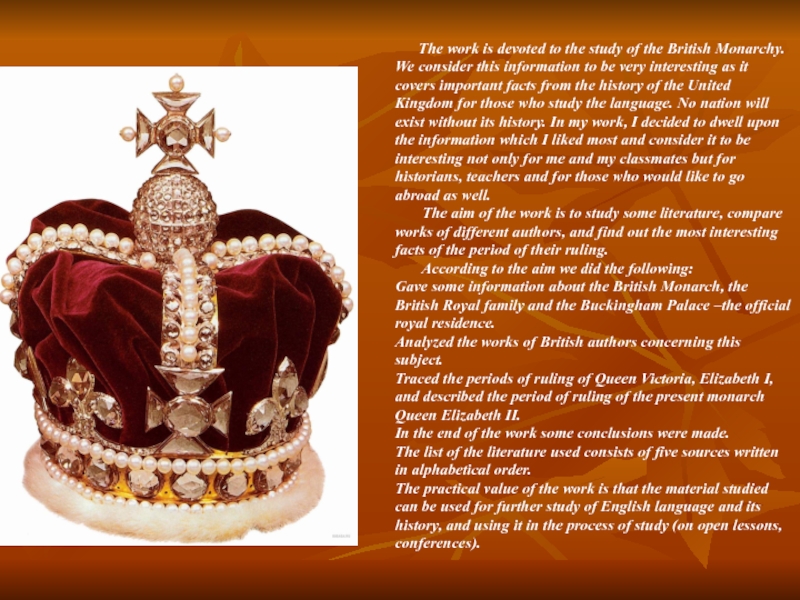
Слайд 13BRITISH ROYAL DYNASTIES
PLANTAGENET
LANCASTER
YORK
TUDOR
STUART
HANNOVER
WINDSOR
Слайд 19DIVORCED, BEHEADED, DIED,
DIVORCED, BEHEADED, SURVIVED.
Слайд 20WIVES OF KING HENRY VIII
Catherine of Aragon
Anne Boleyn
Jane
Seymour
Anne of Cleves
Catherine Howard
Catherine Parr
Слайд 22The Elizabethan era was a time associated with Queen Elizabeth
I's reign (1558–1603) and is often considered to be the
golden age in English history. It was the height of the English Renaissance and saw the flowering of English poetry, music and literature. This was also the time during which Elizabethan theatre flourished, and William Shakespeare and many others composed plays that broke free of England's past style of plays and theatre. It was an age of exploration and expansion abroad, while back at home, the Protestant Reformation became more acceptable to the people, most certainly after the Spanish Armada was repulsed. It was also the end of the period when England was a separate realm before its royal union with Scotland.
Слайд 23The Elizabethan Age is viewed so highly because of the
contrasts with the periods before and after. It was a
brief period of largely internal peace between the English Reformation and the battles between Protestants and Catholics and the battles between parliament and the monarchy that engulfed the seventeenth century. The Protestant/Catholic divide was settled, for a time, by the Elizabethan Religious Settlement, and parliament was not yet strong enough to challenge royal absolutism. England was also well-off compared to the other nations of Europe. The Italian Renaissance had come to an end under the weight of foreign domination of the peninsula. France was embroiled in its own religious battles that would only be settled in 1598 with the Edict of Nantes. In part because of this, but also because the English had been expelled from their last outposts on the continent, the centuries long conflict between France and England was largely suspended for most of Elizabeth's reign [ Stenton; 35-37].
The one great rival was Spain, with which England clashed both in Europe and the Americas in skirmishes that exploded into the Anglo-Spanish War of 1585–1604. An attempt by Philip II of Spain to invade England with the Spanish Armada in 1588 was famously defeated, but the tide of war turned against England with an unsuccessful expedition to Portugal and the Azores, the Drake-Norris Expedition of 1589. Thereafter Spain provided some support for Irish Catholics in a debilitating rebellion against English rule, and Spanish naval and land forces inflicted a series of reversals against English offensives. This drained both the English Exchequer and economy that had been so carefully restored under Elizabeth's prudent guidance. English commercial and territorial expansion would be limited until the signing of the Treaty of London the year following Elizabeth's death [Stenton; 45].
England during this period had a centralized, well-organized, and effective government, largely a result of the reforms of Henry VII and Henry VIII. Economically, the country began to benefit greatly from the new era of trans-Atlantic trade.[New Encyclopaedia Britannica].
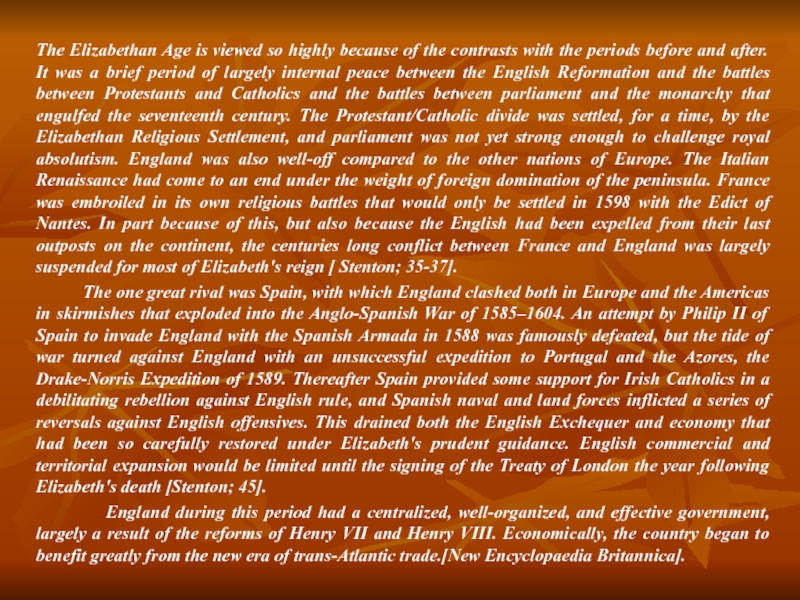
Слайд 27In the modern imagination, Queen Victoria's reign (1837–1901) is perhaps
most remembered as the great age of the British Empire.
Indeed, British holdings around the globe expanded under Victoria's watch to the greatest size of any empire in the history of the world. It is remarkable that Great Britain, a relatively small island nation, was able to dominate world politics by the end of the nineteenth century, with its queen governing over an empire over which, as it was said, the sun never set.
Слайд 28 The reign was a long
period of prosperity for the British people, as profits gained
from the overseas British Empire, as well as from industrial improvements at home, allowed an educated middle class to develop. Some scholars extend the beginning of the period—as defined by a variety of sensibilities and political games that have come to be associated with the Victorians—back five years to the passage of the Reform Act 1832 [The Oxford Illustration of History of Britain].
The era was preceded by the Georgian period and succeeded by the Edwardian period. The latter half of the Victorian era roughly coincided with the first portion of the Belle Époque era of continental Europe and the Gilded Age of the United States.
The era is often characterized as a long period of peace, known as the Pax Britannica, and economic, colonial, and industrial consolidation, temporarily disrupted by the Crimean War, although Britain was at war every year during this time. Towards the end of the century, the policies of New Imperialism led to increasing colonial conflicts and eventually the Anglo-Zanzibar War and the Boer War.
The population of England had almost doubled from 16.8 million in 1851 to 30.5 million in 1901. Ireland’s population decreased rapidly, from 8.2 million in 1841 to less than 4.5 million in 1901. At the same time, around 15 million emigrants left the United Kingdom in the Victorian era and settled mostly in the United States, Canada, and Australia.
During the early part of the era, the House of Commons was headed by the two parties, the Whigs and the Tories. From the late 1850s onwards, the Whigs became the Liberals; the Tories became the Conservatives. These parties were led by many prominent statesmen including Lord Melbourne, Sir Robert Peel, Lord Derby, Lord Palmerston, William Gladstone, Benjamin Disraeli, and Lord Salisbury. The unsolved problems relating to Irish Home Rule played a great part in politics in the later Victorian era, particularly in view of Gladstone's determination to achieve a political settlement. Indeed these issues would eventually lead to the Easter Rising of 1916 and the subsequent domino effect that would play a large part in the fall of the empire [Fry; 21-25].
The reign of Victoria was the longest in British history, and is foreseeably likely to be exceeded only if the present monarch (Queen Elizabeth II) remains on the throne to 2017.
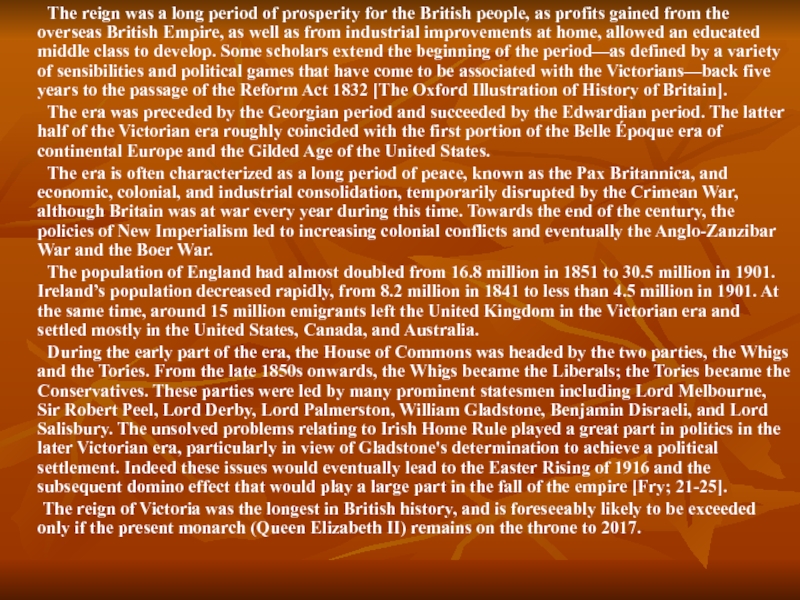
Слайд 34Queen Elizabeth II is the present British monarch who has
been reigning since 1952. She has established herself as a
capable administrator and has reigned for forty six years. Elizabeth II is the eldest daughter of George VI and Elizabeth Bowes Lyon. She married her distant cousin Philip Mountbatten in 1947. Queen Elizabeth has four children. Prince Charles, who is the Prince of Wales, Anne, Andrew and Edward.
Слайд 35Elizabeth II (Elizabeth Alexandra Mary; born 21 April 1926) is
the queen regnant of sixteen independent sovereign states known informally
as the Commonwealth realms: the United Kingdom, Canada, Australia, New Zealand, Jamaica, Barbados, the Bahamas, Grenada, Papua New Guinea, the Solomon Islands, Tuvalu, Saint Lucia, Saint Vincent and the Grenadines, Belize, Antigua and Barbuda, and Saint Kitts and Nevis. She holds each crown separately and equally in a shared monarchy, as well as acting as Head of the Commonwealth, and Supreme Governor of the Church of England. As a constitutional monarch, she is politically neutral and by convention her role is largely ceremonial.
When Elizabeth was born, the British Empire was a pre-eminent world power, but its influence declined, particularly after World War II, and the empire evolved into the modern Commonwealth of Nations. Her father, George VI, was the last Emperor of India. On his death in 1952, Elizabeth became Head of the Commonwealth, and queen of seven independent Commonwealth countries: the United Kingdom, Canada, Australia, New Zealand, South Africa, Pakistan, and Ceylon, later renamed Sri Lanka. During her reign, which at 57 years is one of the longest for a British monarch, she became queen of 25 other countries within the Commonwealth as they gained independence from Britain. She has been the sovereign of 32 individual nations, but half of them later became republics [Mountfield; 55]
